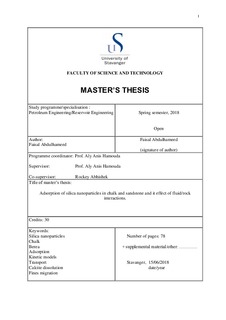| dc.contributor.advisor | Hamouda, Aly | |
| dc.contributor.author | Abdulhameed, Faisal | |
| dc.date.accessioned | 2018-10-22T11:56:23Z | |
| dc.date.available | 2018-10-22T11:56:23Z | |
| dc.date.issued | 2018-06-15 | |
| dc.identifier.uri | http://hdl.handle.net/11250/2568979 | |
| dc.description | Master's thesis in Petroleum engineering | nb_NO |
| dc.description.abstract | This study addresses the adsorption of Silica nanoparticles (NPs) and its effect on fluid/rock interactions in chalk and sandstone reservoirs. The first part of this thesis addresses the kinetic adsorption behaviour of silica NPs dispersed in three types of waters: deionized water (DIW), low salinity water (LSW) and synthetic seawater (SSW) on calcite and quartz which are the major mineral constituents of chalk and sandstone reservoirs. Kinetic adsorption of NPs was addressed by running a set of static adsorption experiments with increasing mixing time between the mineral and silica nanofluid prepared at three different salinities. Pseudo-first order and Pseudo-second order kinetic models were used to describe to kinetic behaviour of silica NPs on calcite and quartz. Intraparticle diffusion model is used to describe the adsorption mechanism of silica NPs on calcite and quartz. Ion and pH analysis was performed to study the fluid/rock interactions with and without NPs. The second part of the thesis addresses the NPs’ transport behaviour, dynamic adsorption/retention and effect on fluid/rock interactions in chalk and sandstone. To address this, single phase core flood experiments were conducted with chalk and Berea sandstone cores at ambient temperature. The effluent produced from these floods was analysed for NP concentration, cations concentration and pH to investigate the fluid/rock interactions.
The kinetic adsorption experiments indicated that the adsorption of NPs on calcite is higher than quartz. It was also shown that the adsorption of NP was enhanced by increasing the salinity. The adsorption of NP on calcite showed best fit with pseudo-second order kinetic model. From this kinetic model, highest adsorption rate of NPs on calcite was in SSW. It was also observed that the estimated adsorption capacity of calcite increased with salinity. Both kinetic models (pseudo-first and second order kinetic model) did not give good fits to describe the adsorption behaviour of NP on quartz. In addition, the kinetic adsorption mechanism of NP on calcite and quartz surfaces was shown to be controlled by intraparticle diffusion and film diffusion mechanisms. The dynamic adsorption experiments in high salinity condition showed strongly irreversible adsorption of NP on Chalk and Berea surfaces. Comparing the results from this thesis to work previously done in our lab showed that: (1) NP adsorption can reduce the calcite dissolution induced by low salinity flooding in chalk reservoirs and (2) NP adsorption can reduced formation damage in sandstone reservoirs. This suggests a synergy between silica nanofluid and low salinity flooding techniques. | nb_NO |
| dc.language.iso | eng | nb_NO |
| dc.publisher | University of Stavanger, Norway | nb_NO |
| dc.relation.ispartofseries | Masteroppgave/UIS-TN-IEP/2018; | |
| dc.subject | Berea | nb_NO |
| dc.subject | petroleumsteknologi | nb_NO |
| dc.subject | reservoarteknologi | nb_NO |
| dc.subject | chalk | nb_NO |
| dc.subject | adsorption | nb_NO |
| dc.subject | kinetic models | nb_NO |
| dc.subject | transport | nb_NO |
| dc.subject | calcite dissolution | nb_NO |
| dc.subject | fines migration | nb_NO |
| dc.subject | silica nanoparticles | nb_NO |
| dc.title | Adsorption of silica nanoparticles in chalk and sandstone and it effect of fluid/rock interactions. | nb_NO |
| dc.type | Master thesis | nb_NO |
| dc.subject.nsi | VDP::Technology: 500::Rock and petroleum disciplines: 510::Petroleum engineering: 512 | nb_NO |
